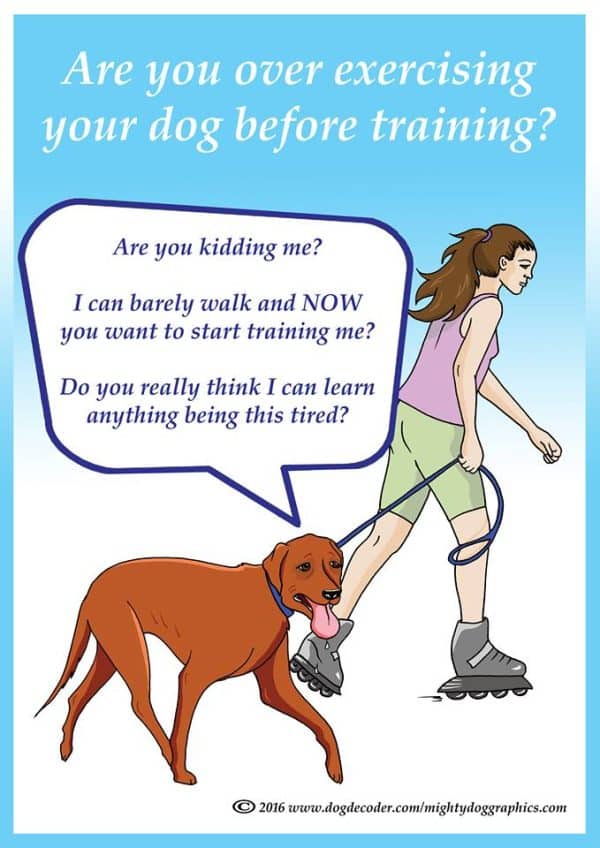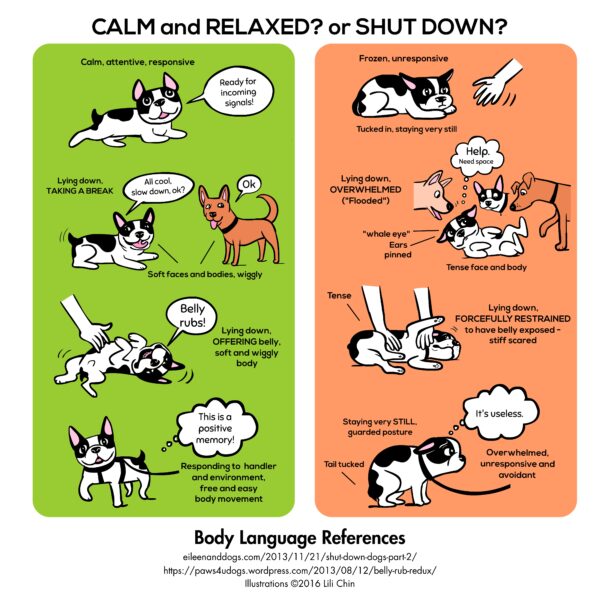Recently, a client sent me a video to watch of Cesar Millan, who was saying that an aggressive dog needed to run before training so that he could “focus his mind.” I was asked my opinion because after the run, the pup’s tongue was very red, thickened, and hanging out; he could barely catch his breath. The dog was drooling and panting so loudly that my client wondered if he could or should do anything in that state, which was clearly one of heat exhaustion. My quick answer to the query was NO, the animal was in distress, both mentally and physically.

While I agree with the concept of letting off some steam before a training session, exercising a dog to the point of exhaustion is just plain wrong. In fact, it drains their capacity for learning.
Follow me! On a good day, training can be stressful for dogs, and while low levels of stress are good for keeping the body and mind moving, too much stress is debilitating. For me, I am in heaven in dance class, but when the instructor challenges me with a new routine, I get stressed, go into learning mode, and focus. If I’ve had a challenging day and didn’t get much sleep the night before, my stress level rises too much, hindering my ability to learn.
So, when you’re working with a dog who is already stressed — say an aggressive, fearful, or reactive one whose anxiety level is at its max — and you make that dog do an endurance exercise like running, swimming, or keeping up on a treadmill (please never do this, as it can be very dangerous), and then you try to train, the dog will not be able to learn. You may even be causing so much stress that they go over their threshold, creating a bite scenario.
In 1878, when the only animals thought to have emotions were humans, anthropologist Charles Letourneau wrote a book called Physiologie des Passions (Physiology of Passions), in which he described the physiological signs and behavioral responses associated with strong emotions, such as fear and anxiety, and how they affect the nervous system and the brain, in that they interrupt “the normal relationship between the peripheral nervous system and the brain.” Although he was referring to humans, we now know all animals have emotions.
Thierry Steimer, PhD, in an article archived in the US National Library of Medicine, National Institutes of Health, explained that Letourneau’s findings show that when brain activity is focused on stress or anxiety, in this scenario that which exists in an aggressive, fearful, or reactive dog, that sensory perceptions may be altered. Add physical exhaustion to emotional stress, and you have a dog who is incapable of learning.

Asking a dog whose mind, body, and emotional state are at their maximum capacity to then focus on training is putting them at risk, which means the trainer is at risk as well. This is not an opportune time for training. In reality, this kind of over-exercising does not make a dog able to “focus his mind” as Millan states in the video clip; it does the opposite. Is it any wonder that Millan and others who use this method are often bitten? I think not.
In my opinion, not only is this kind of exercise bad for an already anxious dog, it also can do structural damage to one not used to this level of exercise. It’s hard on their joints, ligaments, and bones, causing pain for the dog and potentially short- or long-term injury. Being mindful of the physical limitations of a dog whose mental state is already compromised needs to be your primary concern.
In fact, here’s an article, also written about humans (but which still applies to dogs), by KA Brooks and JG Carter that explains what really happens when you over-exercise to the point of exhaustion: Physical and mental functions shut down. This is why we refer to these dogs as being shut down. It’s literally what has happened in their body, mind, and spirit. And not only have they shut down, but they now have a negative association or an aversion to training, which is counter-productive to the original purpose. It is more than likely reinforcing the anxiety you are trying to help the dog overcome.

Learning the signs of stress and the signs of heatstroke so that you can stop your dog before exhaustion will give you a better chance of helping your anxious, stressed pup.
So, what can you do to properly take the edge off a stressed dog before training? You can throw the ball six to seven times, play tug-o-war for a few minutes, do tricks they already know and love, and play games.
You can also help them by learning more about how to work with reactive and aggressive dogs, such as with Dogster resident trainer Annie Phenix’s new best selling book, The Midnight Dog Walkers: Positive Training And Practical Advice For Living With A Reactive or Aggressive Dog.
About the author: Jill Breitner is a professional dog trainer and dog body language expert loving and living her life with family, friends, including her many four-legged friends. She is the author of Dog Decoder, a smartphone app about dog body language. Join Jill on her Dog Decoder Facebook page.





